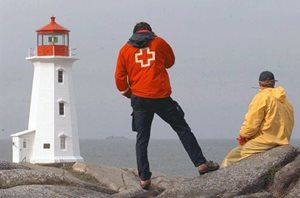 The Canadian Red Cross sent a team to Peggy’s Cove to provide first aid support if survivors were found, or if needed by searchers. Within 48 hours, hope for survivors faded and the operation shifted from rescue to recovery, and to supporting casualties’ families who began arriving from around the world.
The Canadian Red Cross sent a team to Peggy’s Cove to provide first aid support if survivors were found, or if needed by searchers. Within 48 hours, hope for survivors faded and the operation shifted from rescue to recovery, and to supporting casualties’ families who began arriving from around the world.John Byrne who was the Red Cross’s Nova Scotia provincial director at the time described the tragedy as a defining moment in disaster management for the organization.
“There’s not a September 2nd that goes by that it doesn’t reflect on my emotion because that’s what happens in disasters. The Swissair tragedy allowed us to expand and hone our skills, understand the complexities of the event and learn from it.”
Because of the enormity of the event, a new humanitarian level of support evolved from the Red Cross that the government and the community hadn’t seen before.
In partnership with the Nova Scotia Departments of Health, Community Services, and Education, the Red Cross set up a joint emergency operations centre at its provincial headquarters in Halifax. There, personnel from all four agencies worked as one team to support recovery operations and distraught families arriving from two dozen countries. This collaboration later led to a formal agreement between the Canadian Red Cross and Government of Nova Scotia on emergency social services in disasters and emergencies. It was the first such agreement in Canada, has since been expanded and renewed, and has served as a model for other jurisdictions.“From that moment on, we were defined as humanitarian responders in disaster in Nova Scotia which compelled us to be on the same level as we would nationally or internationally from a Red Cross standpoint.” - John Byrne
.jpg.aspx;.pdf;?width=310&height=215) At the height of activity, the Red Cross involved more than 250 volunteers, and about 500 in total over the course of two months, supporting crash recovery and investigation teams, staffing the operations centre, supporting families at a hotel where they received daily updates from the coroner and crash investigators, escorting them to Peggy’s Cove, and distributing 20,000 brochures about coping with traumatic events to homes and schools around St. Margaret’s Bay. Red jackets with the familiar Red Cross logo became an appreciated and easily recognizable sight for families and responders.
At the height of activity, the Red Cross involved more than 250 volunteers, and about 500 in total over the course of two months, supporting crash recovery and investigation teams, staffing the operations centre, supporting families at a hotel where they received daily updates from the coroner and crash investigators, escorting them to Peggy’s Cove, and distributing 20,000 brochures about coping with traumatic events to homes and schools around St. Margaret’s Bay. Red jackets with the familiar Red Cross logo became an appreciated and easily recognizable sight for families and responders.John Webb was the Nova Scotia government’s director of emergency social services at the time but ever since the Swissair tragedy and even more so since retiring from the public service, he’s been a Red Cross volunteer. He remembers well the impact felt by everyone involved.
“It was a huge event in our history. It affected us all personally but we all felt good about doing a little to help the families cope with their loss.”

